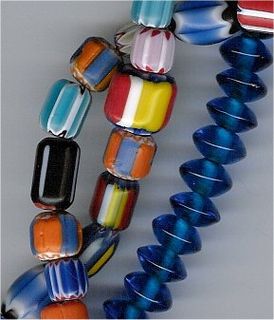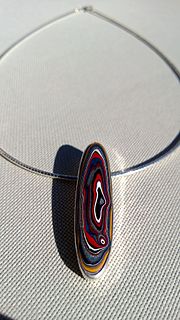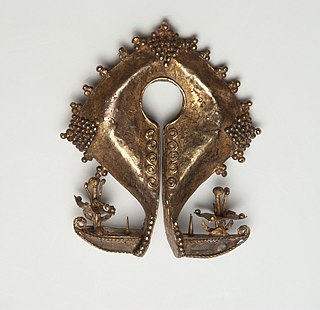 W
WA bail is a component of certain types of jewelry, mostly necklaces, that is used to attach a pendant or stone. The bail is normally placed in the center of the necklace where the pendant hangs.
 W
WA bead is a small, decorative object that is formed in a variety of shapes and sizes of a material such as stone, bone, shell, glass, plastic, wood or pearl and with a small hole for threading or stringing. Beads range in size from under 1 millimetre (0.039 in) to over 1 centimetre (0.39 in) in diameter.
 W
WCameo is a method of carving an object such as an engraved gem, item of jewellery or vessel. It nearly always features a raised (positive) relief image; contrast with intaglio, which has a negative image. Originally, and still in discussing historical work, cameo only referred to works where the relief image was of a contrasting colour to the background; this was achieved by carefully carving a piece of material with a flat plane where two contrasting colours met, removing all the first colour except for the image to leave a contrasting background.
 W
WA butterfly clutch is a device that attaches to the back of a tack pin to secure an accessory to clothing.
 W
WCostume or fashion jewelry includes a range of decorative items worn for personal adornment that are manufactured as less expensive ornamentation to complement a particular fashionable outfit or garment as opposed to "real" (fine) jewelry, which is more costly and which may be regarded primarily as collectibles, keepsakes, or investments. From the outset, costume jewelry — also known as fashion jewelry — paralleled the styles of its more precious fine counterparts
 W
WCrimping is joining two or more pieces of metal or other ductile material by deforming one or both of them to hold the other. The bend or deformity is called the crimp.
 W
WThe figaro chain is a jewellery chain design consisting of two or three small circular links followed by one elongated oval link. The most notable figaro chains are manufactured in Italy. They are usually worn by men and are often adorned with pendants such as crosses and medallions.
 W
WJewellery findings are the parts used to join jewellery components together to form a completed article.
 W
WFordite, also known as Detroit agate or Motor City agate, is old automotive paint which has hardened sufficiently to be cut and polished. It was formed from the buildup of layers of enamel paint slag on tracks and skids on which cars were hand spray-painted, which have been baked numerous times. In recent times the material has been recycled into jewelry.
 W
WA gemstone is a piece of mineral crystal which, in cut and polished form, is used to make jewelry or other adornments. However, certain rocks and occasionally organic materials that are not minerals are also used for jewelry and are therefore often considered to be gemstones as well. Most gemstones are hard, but some soft minerals are used in jewelry because of their luster or other physical properties that have aesthetic value. Rarity is another characteristic that lends value to a gemstone.
 W
WHematite, also spelled as haematite, is a common iron oxide compound with the formula, Fe2O3 and is widely found in rocks and soils. Hematite crystals belong to the rhombohedral lattice system which is designated the alpha polymorph of Fe2O3. It has the same crystal structure as corundum (Al2O3) and ilmenite (FeTiO3). With this it forms a complete solid solution at temperatures above 950 °C (1,740 °F).
 W
WFine metal chains are used in jewellery to encircle parts of the body, namely the neck, wrists and ankles, and they also serve as points to hang decorative charms and pendants. Unlike industrial or chains for other purposes, jewellery chains or body chains are designed for aesthetic purposes.
 W
WJump rings are rings used to make chains, jewelry, and chainmaille. They are made by wrapping wire around a mandrel to make a coil, then cutting the coil with wire cutters to make individual rings. The rings can be assembled one by one into chains, earrings, objects such as bowls or ornaments, and chain mail clothing.
 W
WKolt or kolty was a part of a female headgear, hanging on a ryasna at both temples as a sign of family's wealth, common in 11th-13th centuries in Old Rus'. It comprised a pair of metal pieces, joined to form a hollow medallion or star that, presumably, contained a piece of cloth, impregnated with fragrances.
 W
WLibyan Desert glass or Great Sand Sea glass is an impactite, made mostly of lechatelierite, found in areas in the eastern Sahara, in the deserts of eastern Libya and western Egypt. Fragments of desert glass can be found over areas of tens of square kilometers.
 W
WA lobster clasp, also known as a lobster hook, lobster claw, trigger clasp, or bocklebee clasp, is a fastener that is held closed by a spring. The lobster clasp is opened or closed by holding a small lever, usually with a fingernail, long enough to apply, then it is attached a short link-chain or a ring-like structure. Lobster clasps are often used for necklaces, bracelets, and keychains.
 W
WA locket is a pendant that opens to reveal a space used for storing a photograph or other small item such as a lock of hair. Lockets are usually given to loved ones on holidays such as Valentine's Day and occasions such as christenings, weddings and, most noticeably during the Victorian Age, funerals. Historically, they often opened to reveal a portrait miniature.
 W
WMadaka, also written as mendaka, is a type of precious metal valuable to the Sumba people of Sumba Island, Indonesia. It is found in the megalithic culture of the western Sumba people, e.g. the tribe of Anakalang. Of all precious metal valuable to Sumba people, the madaka is considered to be the most sacred type of gold heirloom.
 W
WMamuli are precious metal ornaments of the Sumba people, Sumba, Indonesia. They are found in the megalithic society of the western Sumba people, e.g. the Anakalang society. The mamuli ornaments have a shape which represents the female genitalia, symbolizing the woman as the giver of life. Mamuli are the most important Sumbanese precious metal valuables and are seen as heirloom objects which served in important exchange rituals.
 W
WMarangga are precious metal valuable of the Sumba people of Sumba Island, Indonesia. They are found in the megalithic culture of the western Sumba people, e.g. the Anakalang society. They have the shape of a twisted metal sheet with a broadened end that has the shape of an axe. The marangga of Sumba is worn hung to the neck as a pendant, forming a kind of chest plate.
 W
WA pearl is a hard, glistening object produced within the soft tissue of a living shelled mollusk or another animal, such as fossil conulariids. Just like the shell of a mollusk, a pearl is composed of calcium carbonate in minute crystalline form, which has deposited in concentric layers. The ideal pearl is perfectly round and smooth, but many other shapes, known as baroque pearls, can occur. The finest quality of natural pearls have been highly valued as gemstones and objects of beauty for many centuries. Because of this, pearl has become a metaphor for something rare, fine, admirable and valuable.
 W
WA pendant is a loose-hanging piece of jewellery, generally attached by a small loop to a necklace, which may be known as a "pendant necklace". A pendant earring is an earring with a piece hanging down. Its name stems from the Latin word pendere and Old French word pendr, both of which translate to "to hang down". In modern French, pendant is the gerund form of pendre and also means "during". The extent to which the design of a pendant can be incorporated into an overall necklace makes it not always accurate to treat them as separate items.
 W
WA rhinestone, paste or diamante is a diamond simulant originally made from rock crystal but since the 19th century from crystal glass or polymers such as acrylic.
 W
WRyasna was a part of a woman’s headgear, hanging from a diadem or as a temporal pendant.